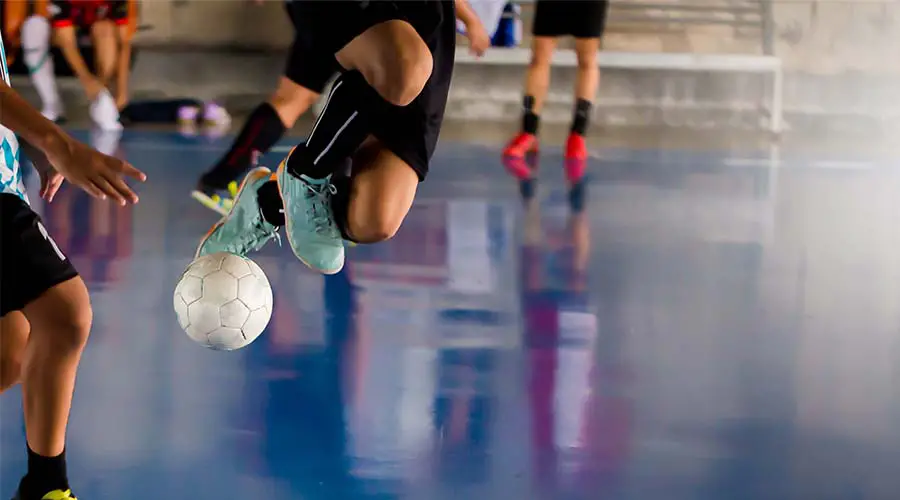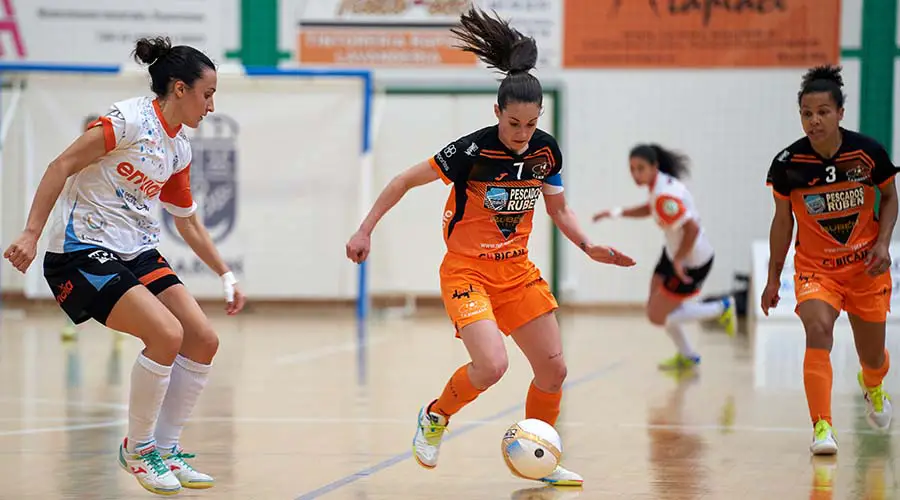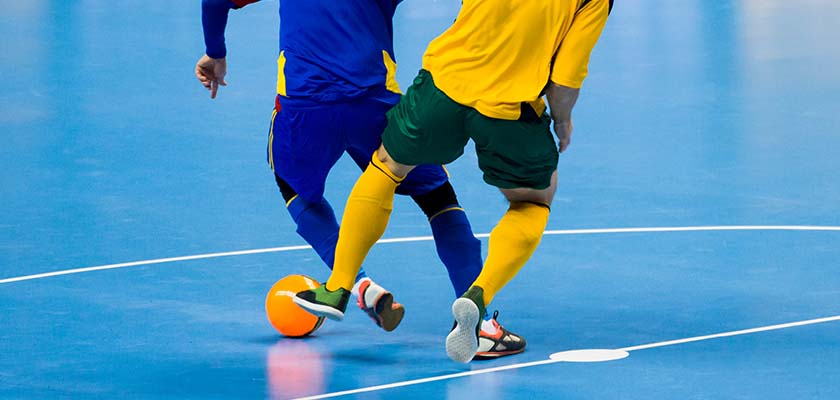What are the futsal tactical systems? How do they work? We’ll answer these questions and much more in this article!
Futsal, one of the most popular sports in the world, is an indoor version of soccer, played on smaller courts and with teams of five players on each side;
Its history begins in the twentieth century, when it began to be practiced on basketball or handball courts, as a form of winter play. Over time, it gained popularity and became an independent, internationally recognized sport.
Brazil is a futsal powerhouse, having won multiple world titles and produced some of the best players in the history of the sport.

Names like Falcão, considered by many to be the greatest futsal player of all time, and Manoel Tobias, known for his skill and vision of the game, are icons of Brazilian sport and world references in terms of technique and talent.
However, success in futsal is not just down to individual players, but also to the tactical systems developed over the years;
The tactical systems of futsal play a crucial role in the course of the game, shaping the way teams position themselves on the court, attack and defend.
Participate in our free Whatsapp community and receive daily tips, news and trivia on over 50 sports! Click here to join.
What is a tactical system?
Futsal’s tactical systems are the essence of a team’s strategy, determining its disposition in both attack and defense.
Choosing the right tactical system is a crucial decision, influenced by the individual characteristics of the players and the specific demands of each match.
How to choose a tactical system
When selecting a tactical system, it is vital to consider a number of factors, including the opponent, the players’ abilities and their level of fitness;
A sensible approach involves adapting the defensive strategy as a starting point, ensuring that the team maintains a cohesive organization when not in possession of the ball.

When it comes to attacking, although tactics are also crucial, it’s important to allow players some flexibility in their positioning, given the dynamism and constant movement in search of space on the court.
Learn about futsal’s main attacking tactical systems
It’s essential to understand that the effective application of futsal’s tactical systems is a question of balancing structure and fluidity;
While defence requires solid organization and well-defined patterns, attack benefits from freedom of movement and the ability of players to adapt.
Futsal tactical systems in attack: 3:1 or Diamond
This configuration is one of the most popular in Futsal, providing a balance between defensive and offensive roles;
It consists of one player designated for attack (the Pivot) and another for defense (the Forward), as well as two Wingers, one on the right and one on the left, who must contribute to both defense and attack.
Advantages of the 3:1 tactical system
- There is a clear distinction between a player who specializes in defense and one who specializes in attack
- The team remains compact both when defending and attacking
Desvantagens do sistema tático 3:1
- If both wingers dedicate themselves too much to attacking, the defense could be vulnerable and the fixed wing overloaded
- There is a risk of overloading the Pivot, especially if the Wingers face offensive difficulties
Futsal tactical systems in attack: 2:2 or Square
The 2:2 tactical formation in Futsal, also known as “Foursquare”, divides a team’s four line players between the defense and attack areas.
It’s a simple system that makes it easy to develop good partnerships between defenders and attackers.
Although two players are assigned to more advanced positions (in attack) and two to more withdrawn positions (in defense), it is crucial that these roles are flexible, as the attackers must be ready to assist in defense and vice versa.
In most teams, both in defense and attack, at least three players are involved.
Advantages of the 2:2 tactical system
- Ideal for beginners
- Provides a balance between attack and defense functions
- Ensures that there is at least one player in both defense and attack throughout the game
Disadvantages of the 2:2 tactical system
- Can restrict player movement
- Can be defensively vulnerable if the defenders venture forward and the forwards don’t take part in the defense
- In poorly trained teams or with poor communication on the court, there can be confusion about which attacker should help defend and which defender should support the attack
Futsal tactical systems in attack: 4:0
The 4:0 tactical scheme in Futsal is used by high-caliber teams, such as those at the professional level.
The premise is that all four players move around simultaneously, creating a dynamic that provides a variety of passing options, space occupation and attacking opportunities.
Advantages of the 4:0 system
- Encourages more dynamic team movement
- Constantly offering pass options
- Complicates the opposition’s defense due to his intense movement
- Can cause considerable physical strain on the defensive team
- The ball circulates quickly, making it difficult to intercept
- It’s an excellent strategy for keeping possession of the ball
- Facilitates effective occupation of court space
- It is an effective way of escaping defensive pressure
- Makes it difficult for the opposing team to cover
Disadvantages of the 4:0 system
- All players on the court MUST understand the system for it to work correctly
- It requires players to be in top physical shape
- If the players focus too much on movement, the team can become predictable and lack offense
- Requires players to have solid technical skills
- Players must have the agility to execute the system effectively
- It can cause considerable physical strain on the players throughout the match
Futsal tactical systems in attack: 3:2
In Futsal, the 3×2 tactical system occurs when the goalkeeper, known as the Goalkeeper Line, leaves his area to take part in his team’s attacking moves. Usually, the goalkeeper is replaced by a line player to increase the system’s offensive effectiveness;
With this formation, the players remain relatively static in their positions, aiming to wear down the opposition’s defenders through quick passes and intense movement around the court.
Advantages of the 3:2 system
- Creates a numerical advantage during the attack
- Facilitates the creation of clear finishing opportunities
Disadvantages of the 3:2 system
- There is a high risk of conceding goals on counter-attacks, as the goalkeeper is out of sight of the goal
- The team can be vulnerable defensively by using a goalkeeper who is not a specialist in defending
List of futsal tactical systems in attack
- Tactical system 2:2 or Square
- Tactical system 3:1 or Diamond
- Tactical system 4:0
- 3:2 tactical system
Learn about futsal’s main tactical systems for defense
In Futsal, the defensive structure includes marking techniques and positioning strategies. A team can adopt individual marking, zone marking or a combination of both.
Futsal tactical systems in defense: individual marking
In individual marking, each player is tasked with marking a specific opponent wherever they move on the court.
Futsal tactical systems in defense: zone marking
In zone marking, each defender is assigned to cover a specific area of the pitch, marking any opposing player who enters this region. Here, the defender doesn’t follow the opponent all over the court, but concentrates on his designated zone.
Futsal tactical systems in defense: mixed marking
Mixed marking combines elements of individual and zone marking, with some players marking individually while others adopt zone marking.
Futsal tactical systems in defense: 3:1
As for specific defensive systems, the 3:1, or rhombus, is used against teams that use the 3:1 or 3:2 systems. The wingers are responsible for covering the wingers, while the pivot closes off the middle to prevent passes to the opposing pivot. The linesman, for his part, must be attentive to covering his teammates.
Futsal tactical systems in defense: 2:2
The 2×2, or square, defensive system is used against teams that adopt the 2×2 or 4×0 systems. Two advanced players maintain their positions, while the two retreated players mark the more advanced players of the opposing team.
List of futsal tactical systems in defense
- Individual marking
- Zone marking
- Combined marking
- 3:1 tactical system
- 2:2 tactical system
Defensive lines in futsal
In futsal defense, the defensive lines play a crucial role in the marking strategy and in containing the opponent.
First line
The first defensive line, also known as line 1, is formed close to the opponent’s goal, where the team applies pressure marking, with the aim of stifling the opponent’s ball and restricting their movements.
Second line
The second defensive line, or line 2, adopts moderate pressure marking. Here, the goalkeeper has a little more space to clear the ball, but as soon as an opposing player gets hold of the ball, the team moves forward to reinforce the pressure on the marking.
Third line
The third defensive line, or line 3, is positioned in the middle of the court, leaving the opponents unmarked in their own defensive half. However, when they enter the attacking half, they face intense marking. This positioning aims to prevent infiltrations and counter-attacks, as well as closing off the middle of the court.
Fourth line
The fourth defensive line, or line 4, is a defensive position set back, close to the 10-meter line in the back court. Here, the team gives the opposition space to possess the ball, but limits their options for infiltration and set-pieces. The aim is to induce counter-attacks and prevent the opposition from creating goal-scoring opportunities.
Now that you know all about futsal tactical systems, how about learning more about other sports?



